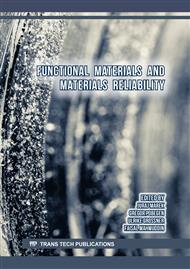[1]
Z. Dai, F. Shi, B. Zhang, M. Li, Z. Zhang. Effect of sizing of carbon fiber surface properties and fiber/epoxy interfacial adhesion, Appl. Surf. Sci. 257 (2011) 6980-6985.
DOI: 10.1016/j.apsusc.2011.09.096
Google Scholar
[2]
J. K. Kocsis, H. Mahmood, A. Pegoretti, Recent advance in fiber/matrix interphase engineering for polymer composites, Prog. Mater. Sci. 73 (2015) 1-43.
DOI: 10.1016/j.pmatsci.2015.02.003
Google Scholar
[3]
L.J. Broutman, B.D. Agarwal, Effect of the interface on the mechanical properties of composites, Rheol. Acta. 13 (1974) 618-626.
DOI: 10.1007/bf01521765
Google Scholar
[4]
Q. Wu, M. Li, Y. Gu, S. Wang, L. Yao, Z. Zhang, Effect of sizing on interfacial adhesion of commercial high strength carbon fiber-reinforced resin composites, Polym. Compos. 37 (2016) 254-261.
DOI: 10.1002/pc.23176
Google Scholar
[5]
B. A. Budiman, K. Takahashi, K. Inaba and K. Kishimoto, A new method of evaluating interfacial properties of a fiber/matrix composite, J. Compos. Mater. 49(4) (2015) 465-475.
DOI: 10.1177/0021998314521061
Google Scholar
[6]
B. A. Budiman, K. Takahashi, K. Inaba and K. Kishimoto, Evaluation of interfacial strength between fiber and matrix based on cohesive zone modeling, Compos. - A: Appl. Sci. Manuf. 90 (2016) 211-217.
DOI: 10.1016/j.compositesa.2016.06.024
Google Scholar
[7]
B. A. Budiman, F. Adziman, P. L. Sambegoro, I. P. Nurprasetio, R. Ilhamsyah and M. Aziz, The role of interfacial rigidity to crack propagation path in fiber reinforced polymer composite, Fibers Polym. 19(9) (2018) 1980-1988.
DOI: 10.1007/s12221-018-8194-z
Google Scholar
[8]
H. D. Wagner, J. A. Nairn, M. Detassis, Toughness of interfaces from initial-matrix debonding in a single fiber composite fragmentation test, Appl. Compos. Mater. 2 (1995) 107-117.
DOI: 10.1007/bf00569253
Google Scholar
[9]
S. Kimura, J. Konayagi and H. Kawada, Evaluation of initiation of the interfacial debonding in single-fiber composites (Energy balance method considering an energy dissipation of the plastic deformation), JSME Inter. J., 49 (2006) 451-457.
DOI: 10.1299/jsmea.49.451
Google Scholar
[10]
C. T. Chou and L. S. Penn, Chemical bonding and physical interaction by attached chains at the fiber-matrix interface, J. Adhes. 36(2-3) (1991) 125-137.
DOI: 10.1080/00218469108027067
Google Scholar
[11]
E. Pisanova and E. Mäder, Acid–base interactions and covalent bonding at a fiber–matrix interface: contribution to the work of adhesion and measured adhesion strength, J. Adhes. Sci. Technol. 14(3) (2000) 415-436.
DOI: 10.1163/156856100742681
Google Scholar
[12]
B. A. Budiman, F. B. Juangsa, M. Aziz, I. P. Nurprasetio and I. N. Zaini, Experimental verification of interfacial strength effect on the mechanical properties of carbon fiber-epoxy composite. Int. J. Adv. Sci. Eng. Inf. Technol. 7(6) (2017) 2226-31.
DOI: 10.18517/ijaseit.7.6.2781
Google Scholar
[13]
I. S. Putra, B. A. Budiman, P. L. Sambegoro, S. P. Santosa, A. I. Mahyuddin, K. Kishimoto, and K. Inaba, The influence of fiber surface profile and roughness to fiber–matrix interfacial properties. J. Compos. Mater., 54(11) (2020) 1441-1452.
DOI: 10.1177/0021998319883418
Google Scholar
[14]
D. J. Eyckens, B. Demir, J. D. Randall, T. R. Gengenbach, L. Servinis, T. R. Walsh and L. C. Henderson, Using molecular entanglement as a strategy to enhance carbon fiber-epoxy composite interfaces. Compos. Sci. Technol., 196 (2020) 108225.
DOI: 10.1016/j.compscitech.2020.108225
Google Scholar
[15]
B. A. Budiman, P. Sambegoro and P. N. Halimah, Graphite surface profile with different polishing treatment, In Journal of Physics: Conference Series, IOP Publishing, 1402(5) (2019) 055094.
DOI: 10.1088/1742-6596/1402/5/055094
Google Scholar
[16]
B. A. Budiman, P. N. Halimah, Interface damage mechanics in fiber reinforced plastic composite–A review. AIP Conference Proceedings, AIP Publishing LLC, 2217(1) (2020) 020002.
DOI: 10.1063/5.0000808
Google Scholar
[17]
B. Fiedler and K. Schulte, Photoelastic analysis of fibre reinforced model composite materials, Comp. Sci. Tech. 57 (1997) 859-867.
Google Scholar
[18]
F. Zhao, S. Hayes, E. Patterson and F. Jones, Phase-stepping photoelasticity for the measurement of interfacial shear stress in single fibre composites, Comp. Part A, 37 (2006) 216-221.
DOI: 10.1016/j.compositesa.2005.09.021
Google Scholar
[19]
E. Flores-Johnson, J. Vazquez-Rodriguez, P. Herrera-Franco and P. Gonzalez-Chi, Photoelastic evaluation of fiber surface-treatments on the interfacial performance of a polyester fiber/epoxy model composite, Comp. Part A, 42 (2011) 1017-1024.
DOI: 10.1016/j.compositesa.2011.04.005
Google Scholar
[20]
C. Galiotis, V. Chohan, A. Paipetis and C. Vlartas, Interfacial measurement and fracture characteristics of single and multi-fiber composites by remote laser raman spectroscopy, Fiber, Matrix, and Interface Properties, (1996) 19-33.
DOI: 10.1520/stp38223s
Google Scholar
[21]
A. Paipetis, C. Galiotis, Y. Ching Liu and J. A. Nairn, Stress transfer from the matrix to the fibre in a fragmentation test: raman experiments and analytical modeling, J. Comp. Mater., 33 (1996) 377-399.
DOI: 10.1177/002199839903300404
Google Scholar
[22]
Y. Huang and R. J. Young, Analysis of the fragmentation test for carbon fibre/epoxy model composites by means of raman spectroscopy, Compos. Sci. Technol., 52 (1994) 505-517.
DOI: 10.1016/0266-3538(94)90033-7
Google Scholar
[23]
H.L. Cox, The elasticity and strength of paper and other fibrous materials, Brit. J. Appl. Phys. 3 (1952) 72-78.
Google Scholar
[24]
F. Ma and K. Kishimoto, A continuum interface debonding model and application to matrix cracking of composite, JSME Inter. J., 39A (1996) 496-507.
DOI: 10.1299/jsmea1993.39.4_496
Google Scholar
[25]
S. Ogihara, Y. Imafuku, R. Yamamoto, Y. Kogo, Direct evaluation of fracture toughness in a carbon fiber, 17th ICCM, Edinburg, 2009.
Google Scholar



